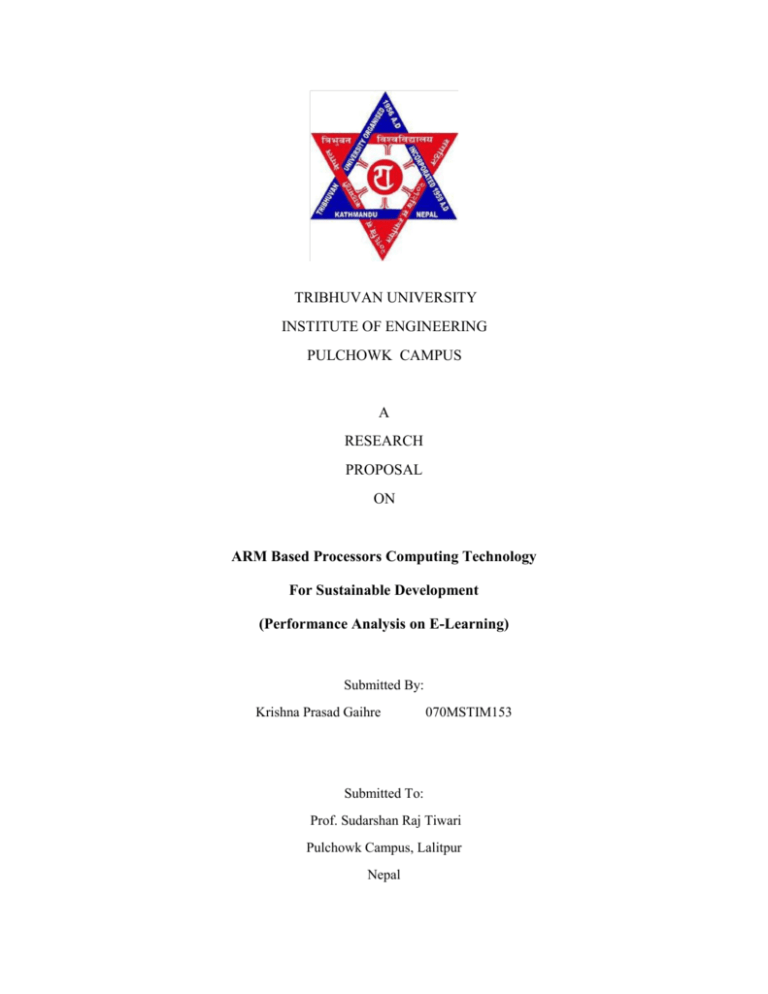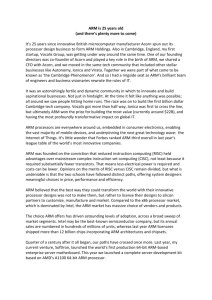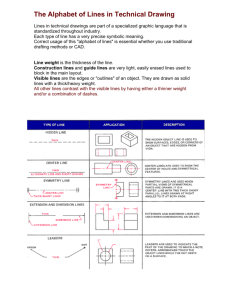TRIBHUVAN UNIVERSITY INSTITUTE OF ENGINEERING
advertisement

TRIBHUVAN UNIVERSITY INSTITUTE OF ENGINEERING PULCHOWK CAMPUS A RESEARCH PROPOSAL ON ARM Based Processors Computing Technology For Sustainable Development (Performance Analysis on E-Learning) Submitted By: Krishna Prasad Gaihre 070MSTIM153 Submitted To: Prof. Sudarshan Raj Tiwari Pulchowk Campus, Lalitpur Nepal ARM Based Processors Computing Technology for Sustainable Development (Performance Analysis on E-Learning) Introduction: ARM (Advanced RISC Machines) Limited has designed a family of RISC (Reduced Instruction Set Computer)-style processor, ARM licenses this designs to other companies for chip fabrication,together with software tools for system development and simulation. Processors based on designs licensed from ARM, or designed by licensees of one of the ARM instruction set architectures, are used in all classes of computing devices from microcontrollers in embedded systems – including real-time safety systems smartTVs (Google TV) and all modern smartwatches (such as Qualcomm Toq) – up to smartphones (such as all Apple's iPhones), tablets (such as all Apple's iPads), laptops (some Chromebook versions), desktops (first use was in the Acorn Archimedes), servers and supercomputers/HPC . A characteristic feature of ARM processors is their low electric power consumption, which makes them particularly suitable for use in portable devices.In fact, almost all modern mobile phones and personal digital assistants contain ARM CPUs, and making them the most widely used 32-bit microprocessor family in the world. Today ARMs account for over 75% of all 32-bit embedded CPUs. ARM-based CPU market share in 2010: over 95% in smartphone market; 10% in mobile computers; 35% in digital TVs and set-top boxes. For example, one of ARM’s most successful cores is the ARM7TDMI. It provides up to 120 Dhrystone (Dhrystone MIPS version 2.1 is a small benchmarking program) MIPS1 and is known for its high code density and low power consumption, making it ideal for mobile embedded devices. (Sloss, Symes, & Wright, 2005) Increasingly the trend in embedded system design is to integrate all the major system functions apart from some memory components into a single chip. The benefits in terms of component costs, reliability and power-efficiency are considerable. The development that makes this possible is the advance in semiconductor process technology which now allows chips incorporating millions of transistors to be built cheaply, and within a few years will allow tens of millions of transistors on a chip. The ARM has played a leading role in the opening of this era since its very small core size leaves more silicon resources available for the rest of the system functions.(Furber, 2000) The core idea of sustainability is that current generations should meet their own needs without compromising the ability of future generations to meet theirs. The specific aims of global sustainability, as defined by the Kyoto Protocol, can be summarized as follows (Sustainable Computing by Sun Microsystems, 2005): 1.To reduce global resource extraction by half 2. To decouple resource use from economic growth 3. To increase the efficiency of primary resource use 4. To decrease energy requirements by 4-10 fold The goals of sustainable computing initiatives in Facilities Services focus on reducing the environmental footprint and impacts. Designing, Manufacturing the Digital system with reducing, reusing, and recycling by centering initiatives in the areas of power, waste, purchasing, and education efficiently and effectively with minimal or no impact on the environment .(Sustainable Computing, Cornell university) The area of the sustainable computing and communications are as follows: 1. Green Data Centers 2. Algorithms for Reduced Power, Energy and Heat 3. Energy Efficient Network Hardware 4. Energy-Efficient Communication Protocols 5. Ecological monitoring, analytics and visualization 6. Low power wireless communication technologies Litreture Review Sustainable development is an organizing principle for human life on a finite planet. It posits a desirable future state for human societies in which living conditions and resource-use meet human needs without undermining the sustainability of natural systems and the environment, so that future generations may also have their needs met. Processors are mostly used in the computing or processing system which gets the huge raw data and it processes it in to useful information which is necessary for the decision making purposes with the help of human decision or autonomously. This Processing capability of the ARM processor can be applied on different fields which has relation on daily life of human beings and society. The important features of the ARM Processor are the Thumb instruction which is 16 bit compressed form of the original 32 bit ARM instruction set, and employs dynamic decompression hardware in the instruction pipeline. Most of the principles of modern SoC (System on chip) and processor design are illustrated some- where in the ARM family, and ARM has led the way in the introduction of some concepts (such as dynamically decompressing the instruction stream). The inherent simplicity of the basic 3-stage pipeline ARM core makes it a good pedagogical intro- ductory example to real processor design, whereas the debugging of a system based around an ARM core deeply embedded into a complex system chip represents the cutting-edge of technological development today(Furber, 2000).The Dynamic decompressing of the instruction stream makes the Processor more fast and efficient on the resource utilization on such of that the processor need less power than the other similar type of processors. ARM put a lot of effort into various areas to ensure the Cortex-M0 processor could reach its low powerconsumption target. These areas include the following: small gate count, high efficiency, low-power features (sleep modes), and logic cell enhancement. (Yiu, 2009) ARM Processor are becoming the part of the development and increasing the Ubiquitous computing environment. This family can role vital role for the sustainable development. In the developing countries this family processor are used for e-Education, e-medicine, industrial purposes and Telecommunication to the ICT For education, CT for agriculture etc.. This uses can reduce the dependent of the large RISC processor architecture (64 bit processor) to the 32 bit processor with most of the computing capability . There is a common misconception that ICT-based Education is about teaching students computer skills. ICT-based Education is about using computers and technology as tools to enrich learning in various subjects such as English, Science and Mathematics.(OLE Nepal, 2013) The new laptops for Rural area with new features which makes it a more suitable device for the rural public schools. It runs on ARM based processor which makes the laptop a much faster machine than the previous versions. It has more memory, storage and speed and consumes 40% less power and has a touchscreen feature.(NEPAL, 2013) Using low power Raspberry Pis as digital library clients which is helpful to improve the quality of the EPustakalaya contents and efficient devices for digital library setup that uses low power. At present, the system-on-chip (SoC) devices like Raspberry-Pi and Odroid as low-cost low-power alternatives to provide easy access to resources at schools. Odriod is powerful enough to replace current school server and the setting up E-Pustakalaya server on an Odriod device is not complicated tasks. Once the setup is successful, it is suitable for looking DC monitors to go with the client machines. This system can power up the whole computer lab with 10 to 12 Raspberry-Pi devices with a moderate sized battery without having to use power Inverter so that the power is not lost in conversion .(OLE Nepal, 2013) While Computing Power on the field of Agriculture the ARM based Embedded System be the efficient solution .According to space constraints of the traditional agricultural environment monitoring system, a small database called SQLite was transplanted into the ARM and Linux operation which could store and manage the field information.Users can get information anytime and anywhere through the GSM(global system for Mobile Communication) network and the WSN(Wireless Sensor Network) by the design,instead of the inquiring from the PC(Personal Computer) which was widely used now.Sensors embedded in the environment, information spread in the air and capture by the hanheld instruments, which is a typical application of pervasive computing.(Hu Zhao, 2011) Problem Statement Current trend and application of the computing environment consists of different types of processor architecture(8 bit,16 bit,32 bit, 64 bit).Mostly Embedded system and small end purpose systems is consists of 64 bit lower processor architecture and for the sustainable computing concepts on specific end purposes consists 32 bit architecture. The 64 bit RISC Processor from different manufacturer need more interfacing systems, they need external memory controller , I/O controller and other controlling unit this system need more power than other systems with 32 bit less bit architecture. In the large data centers there are millions of this family of processor, which need large amount of power. The ideology of Green computing is that the reducing in the consumption of the processing power with the same computing capability. Due to the architecture complexity in the intel ,AMD,NIVIDIA and other company processor need more power and this processor are not economical for the small designs purposes. While ARM processor can be used for the small ended products and devices and can consume the less power than other processor family. For the small end and economical purposes this high end processor has following complexity 1. Architecture complexity and large interface controlling units. 2. Need large amount of economic resources for the small end setup. 3. Need large amount of power than the ARM processor. But the ARM processor have SoC(system on chip) interface controller like I/O controller , RAM, and other computing units so it need less complex hardware and its interface require less power.ARM processor are recently used in educational purposes as in ICT for education , a small minicomputer build by arm processor family(Rasbarry Pi, ARM cortex series processor) this minicomputer are mostly used in elearning and computer based learning purpose, because this minicomputer consists of special linux version of operating system and external SD card interface can hold other programs and learning materials. The computing power of the ARM processor can be implementing on the developing countries environment as Nepal while this system is affordable for the less economic capability community, which need less power, power is the major problems. The major computing environment need more power but the system with the same capability of the major computing environment with the use of ARM processors need less power which can be used even on the help of low power Solar P-V cell system which is available power supply system on the major rural area of Nepal. This research aims to find out the Performance and effectiveness of the specific small end computing environment with the enhancement of ARM based processing system for the E-learning purposes which are already installed for the ICT based education in public school on the rural community of Nepal . By the help of already specified characteristics and features of the processing unit (ARM processor) by the manufacturer and researcher this research find out the implemented Processing system and its performance on the rural society for the sustainable development arena . Objective This Research has aimed to the identification of computing technology mostly used in the current scenario in different fields (Education, Agriculture, industries, etc.) by the help of specified characteristics by the manufacturer and researcher and investigating the performance with effectiveness of the system. Suggesting how it is efficiency in the context of power and economical status can be applied for the sustainable development propose. General objective How to increase the Performance and effectiveness of the computing platform is the main objective of this research on the basis of specified technical and design details of processing system. The direct impact of this technology which occur when applying the technology before and after will be analyzed and the new application sectors will identified. The improvements on the current Application system and establishment of the newer system for the daily life purposes(Agriculture, education, business etc.) will be suggested and most efficient system(Embedded system) Processor family will be identified for the small end purposes. Specific objective Specific objective can be listed as below 1. Finding the effectiveness of the ARM computing systems and its performance on the E-Learning purposes on public school students of the rural society. 2. Processing capability and effectiveness of ARM Processors for the general aspects and professional aspects. 3. Identifying the possibility of this technology for the more advance applications (ICT for Agriculture, ICT for Education and other sectors) for sustainable growth. Methodology In this Research Following Methodologies will be apply 1. Reviewing the system literature: current aspects and problems on the application and development of the efficient systems. 2. Collecting the Real time available data: Consulting with the NGO(OLE Nepal) and other Firms about the Effectiveness of the ARM Processor Based minicomputer E-learning methods and current application sectors. 3. Collecting the international data on the application of the technology for the ubiquitous computing purposes. 4. Analyzing the Performance and effectiveness of the ARM based systems on learning and development of the society. 5. Investigating the New era on the computing environment for the sustainable development Expected Output What is the performance of the ARM based systems on E-learning on the school children and its effectiveness than the other high end computing environment will be analyzed and conclude .How the ARM based Processor computing technology can be used for different relevant fields for the sustainable development, and what is the direct impact of this technology in daily life of the people. The specific architecture of the ARM processor family will be suggested on the basis of technical and design data available for the small low end purpose in the context of sustainable development. Schedule The research work steps will be as follows: understanding and collecting the current literature: Week 1 to 3. Gathering the available real time data (consulting, internet): Week 3 to 8. Analyzing the gathered data and investigation of the appropriate system for suggesting: Week 9 to 12. Purpose the model system: Week 13 to 18 Report writing: week 18 to 24. Submission of research outcome: end of six months (Mid of Next Semester) References Furber, S. (2000). ARM System-on-Chip Architecture (Second Edition ed.). Adission Wesley. OLE Nepal. (2013). Retrieved from OLE Nepal: http://www.olenepal.org Seal, D. (n.d.). Free ARMv7-AR,ARMv7-M,ARMv6-M and ARMv5 Architecture Reference Mannual Downloads. Addison Wesley. Sloss, A. N., Symes, D., & Wright, C. (2005). ARM System Devloper's Guide. Morgan Kufmann. Yiu, J. (2009). The Definitive Guide to the ARM Cortex-M3. Newnes. http://www.arm.com/products/processors/index.php http://computing.fs.cornell.edu/sustainable/fsit_sustainability.cfm NEPAL, O. (2013, 12). ole_newsletter. Retrieved from olenepal: http://www.olenepal.org/ole_newsletterr/issue_23/index.html#page4/ Hu Zhao, S. W. (2011). Perasive Agricultural Environment Monitoring System Based on Embedded Database. IFIP Advances in Information and Communication Technology , Volume 345, pp 166-176. Zhou, G., Zhou, J., Miao, Y., Liu, C.: Development and application on GSM-based monitoring system for digital agriculture. Transactions of the CASE, 158–163 (2009).






